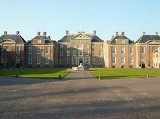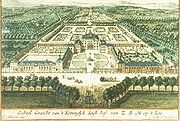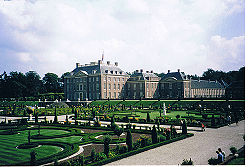
Het Loo
Encyclopedia



Palace
A palace is a grand residence, especially a royal residence or the home of a head of state or some other high-ranking dignitary, such as a bishop or archbishop. The word itself is derived from the Latin name Palātium, for Palatine Hill, one of the seven hills in Rome. In many parts of Europe, the...
in Apeldoorn
Apeldoorn
Apeldoorn is a municipality and city in the province of Gelderland, about 60 miles south east of Amsterdam, in the centre of the Netherlands. It is a regional centre and has 155,000 . The municipality of Apeldoorn, including villages like Beekbergen, Loenen and Hoenderloo, has over 155,000...
, Netherlands
Netherlands
The Netherlands is a constituent country of the Kingdom of the Netherlands, located mainly in North-West Europe and with several islands in the Caribbean. Mainland Netherlands borders the North Sea to the north and west, Belgium to the south, and Germany to the east, and shares maritime borders...
. The symmetrical
Symmetry
Symmetry generally conveys two primary meanings. The first is an imprecise sense of harmonious or aesthetically pleasing proportionality and balance; such that it reflects beauty or perfection...
Dutch Baroque building was designed by Jacob Roman and Johan van Swieten and was built between 1684 and 1686 for stadtholder
Stadtholder
A Stadtholder A Stadtholder A Stadtholder (Dutch: stadhouder [], "steward" or "lieutenant", literally place holder, holding someones place, possibly a calque of German Statthalter, French lieutenant, or Middle Latin locum tenens...
-king
King
- Centers of population :* King, Ontario, CanadaIn USA:* King, Indiana* King, North Carolina* King, Lincoln County, Wisconsin* King, Waupaca County, Wisconsin* King County, Washington- Moving-image works :Television:...
William III
William III of England
William III & II was a sovereign Prince of Orange of the House of Orange-Nassau by birth. From 1672 he governed as Stadtholder William III of Orange over Holland, Zeeland, Utrecht, Guelders, and Overijssel of the Dutch Republic. From 1689 he reigned as William III over England and Ireland...
and Mary II of England
Mary II of England
Mary II was joint Sovereign of England, Scotland, and Ireland with her husband and first cousin, William III and II, from 1689 until her death. William and Mary, both Protestants, became king and queen regnant, respectively, following the Glorious Revolution, which resulted in the deposition of...
. The garden was designed by Claude Desgotz
Claude Desgotz
Claude Desgotz was the nephew and protegé of André Le Nôtre, the designer of the French formal gardens at Vaux-le-Vicomte and Versailles that set the pattern for grand gardening in France up to the Revolution, in spite of increasing competition from the informal English landscape style...
.
The palace was a residence of the House of Orange-Nassau
House of Orange-Nassau
The House of Orange-Nassau , a branch of the European House of Nassau, has played a central role in the political life of the Netherlands — and at times in Europe — since William I of Orange organized the Dutch revolt against Spanish rule, which after the Eighty Years' War...
from the 17th century until the death of Queen Wilhelmina
Wilhelmina of the Netherlands
Wilhelmina was Queen regnant of the Kingdom of the Netherlands from 1890 to 1948. She ruled the Netherlands for fifty-eight years, longer than any other Dutch monarch. Her reign saw World War I and World War II, the economic crisis of 1933, and the decline of the Netherlands as a major colonial...
in 1962. The building was renovated between 1976 and 1982. Since 1984, the palace is a state museum
Rijksmuseum
The Rijksmuseum Amsterdam or simply Rijksmuseum is a Dutch national museum in Amsterdam, located on the Museumplein. The museum is dedicated to arts, crafts, and history. It has a large collection of paintings from the Dutch Golden Age and a substantial collection of Asian art...
open for the general public, showing interiors with original furniture, objects and paintings of the House of Orange-Nassau.
Architecture
The Dutch Baroque architecture of Het Loo takes pains to minimize the grand stretch of its construction, so emphatic at Versailles, and present itself as just a fine gentleman's residence. Het Loo is not a palacePalace
A palace is a grand residence, especially a royal residence or the home of a head of state or some other high-ranking dignitary, such as a bishop or archbishop. The word itself is derived from the Latin name Palātium, for Palatine Hill, one of the seven hills in Rome. In many parts of Europe, the...
but, as the title of its engraved portrait (illustration, below) states, a "Lust-hof" (a retreat, or "pleasure house"). Nevertheless, it is situated entre cour et jardin ("between court and garden") as Versailles and its imitators, and even as fine Parisian private houses are. The dry paved and gravelled court, lightly screened from the road by a wrought-iron grill, is domesticated by a traditional plat of box-bordered green, the homey touch of a cross in a circle you'd find in a bougeois garden. The volumes of the palace are rhythmically broken in their massing. They work down symmetrically, expressing the subordinate roles of their use and occupants, and the final outbuildings in Marot's plan extend along the public thoroughfare, like a well-made and delightfully regular street.
Garden
The "Great Garden" lies privately behind. This Dutch Baroque Garden, when miscalled the "Versailles of HollandPalace of Versailles
The Palace of Versailles , or simply Versailles, is a royal château in Versailles in the Île-de-France region of France. In French it is the Château de Versailles....
" serves to show more differences than similarities, still within the Baroque general formula established by André Le Nôtre
André Le Nôtre
André Le Nôtre was a French landscape architect and the principal gardener of King Louis XIV of France...
: perfect symmetry, axial layout with radiating gravel walks, parterre
Parterre
A parterre is a formal garden construction on a level surface consisting of planting beds, edged in stone or tightly clipped hedging, and gravel paths arranged to form a pleasing, usually symmetrical pattern. Parterres need not have any flowers at all...
s with fountains, basins and statues. The garden as it appears in the engraving (illustration) was designed by Le Nôtre's nephew, Claude Desgotz
Claude Desgotz
Claude Desgotz was the nephew and protegé of André Le Nôtre, the designer of the French formal gardens at Vaux-le-Vicomte and Versailles that set the pattern for grand gardening in France up to the Revolution, in spite of increasing competition from the informal English landscape style...
. In his military and diplomatic career, William of Orange was the European opponent of Louis XIV, the commander of the combined forces countering those of absolute power and Roman Catholicism. André Le Nôtre
André Le Nôtre
André Le Nôtre was a French landscape architect and the principal gardener of King Louis XIV of France...
's main axis at Versailles, continued by the canal, runs up to the horizon. Daniel Marot
Daniel Marot
Daniel Marot was a French Protestant, an architect, furniture designer and engraver at the forefront of the classicizing Late Baroque "Louis XIV" style....
and Desgotz's Het Loo garden does not dominate the landscape as Louis' German imitators do, though in his idealized plan (engraving, left), Desgotz extends the axis. The main garden, with conservative rectangular beds instead of more elaborately shaped ones, is an enclosed space surrounded by raised walks, as a Renaissance garden might be, tucked into the woods for private enjoyment, the garden not of a king but of a stadhouder. At its far end a shaded crosswalk of trees disguised the central vista. The orange trees set out in wooden boxes and wintered in an Orangery
Orangery
An orangery was a building in the grounds of fashionable residences from the 17th to the 19th centuries and given a classicising architectural form. The orangery was similar to a greenhouse or conservatory...
, which were a feature of all gardens, did double duty for the House of Orange-Nassau.
Outside the garden there are a few straight scenic avenues
Avenue (landscape)
__notoc__In landscaping, an avenue or allée is traditionally a straight route with a line of trees or large shrubs running along each, which is used, as its French source venir indicates, to emphasize the "coming to," or arrival at a landscape or architectural feature...
, for following the hunt in a carriage, or purely for the vista afforded by an avenue. Few of the "green rooms" cut into the woodlands in imitation of the cabinets de verdure of Versailles that are shown in the engraving actually got executed at Het Loo.
The patron of the Sun King's garden was Apollo. Peter the Great
Peter I of Russia
Peter the Great, Peter I or Pyotr Alexeyevich Romanov Dates indicated by the letters "O.S." are Old Style. All other dates in this article are New Style. ruled the Tsardom of Russia and later the Russian Empire from until his death, jointly ruling before 1696 with his half-brother, Ivan V...
would opt for Samson, springing the jaws of Sweden's heraldic lion. William opted for Hercules
Heracles
Heracles ,born Alcaeus or Alcides , was a divine hero in Greek mythology, the son of Zeus and Alcmene, foster son of Amphitryon and great-grandson of Perseus...
.
In the 18th century, William III’s baroque garden as seen in the engraving was swept away for a landscape park in the English taste.
Restoration of the garden
In 1960 Queen WilhelminaWilhelmina of the Netherlands
Wilhelmina was Queen regnant of the Kingdom of the Netherlands from 1890 to 1948. She ruled the Netherlands for fifty-eight years, longer than any other Dutch monarch. Her reign saw World War I and World War II, the economic crisis of 1933, and the decline of the Netherlands as a major colonial...
declared that when she died the palace would go to the State. She did however request that it would be returned to her family if the Dutch were to abolish the monarchy. The palace became property of the Dutch state in 1962, when Wilhelmina died at Het Loo Palace. After a thorough restoration it now houses a national museum and library devoted to the House of Orange-Nassau in Dutch history. Het Loo also now houses the Museum van de Kanselarij der Nederlandse Orden (Museum of the Chancery of the Netherlands Orders of Knighthood), and books and other material concerning decorations and medals form a separate section in the library.
The lost gardens of Het Loo were fully restored starting in 1970, in time to celebrate its tricentennial in 1984. Its new brickwork, trelliswork and ornaments are as raw as they must have been in 1684 and will mellow with time.
See also
- List of Baroque residences
- De Naald - monument nearby Het Loo

